Classroom Management: Theories, Guidelines, and Complications
VerifiedAdded on 2022/08/29
|12
|2380
|36
Essay
AI Summary
This essay provides a comprehensive overview of classroom management, emphasizing its importance in education. It delves into the multifaceted nature of managing student behavior and fostering a positive learning environment. The discussion encompasses major complications in the classroom, such as indiscipline and class bunking, and identifies key factors crucial for student motivation, including traits and states, affect and interest, anxiety and arousal, and intrinsic versus extrinsic motivation. The essay explores various motivational theories, including behavioral, social cognitive, humanist, and cognitive explanations, highlighting their application in creating an effective classroom. Furthermore, it outlines discipline guidelines for teachers, emphasizing the importance of a structured and supportive classroom environment. The conclusion underscores the significance of motivation and effective teaching strategies in successful classroom management, stressing the role of teachers in mitigating negative student behaviors.
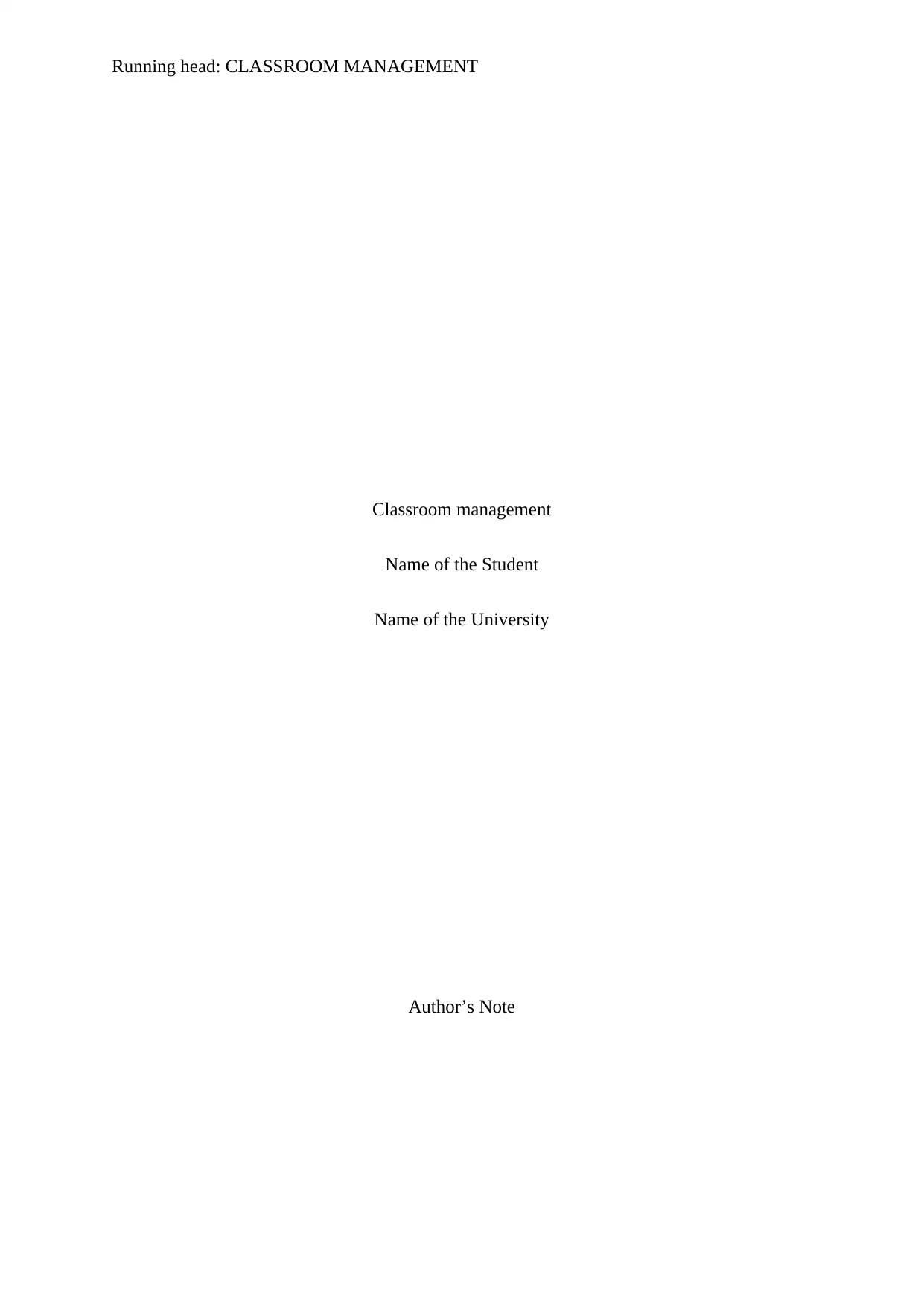
Running head: CLASSROOM MANAGEMENT
Classroom management
Name of the Student
Name of the University
Author’s Note
Classroom management
Name of the Student
Name of the University
Author’s Note
Paraphrase This Document
Need a fresh take? Get an instant paraphrase of this document with our AI Paraphraser
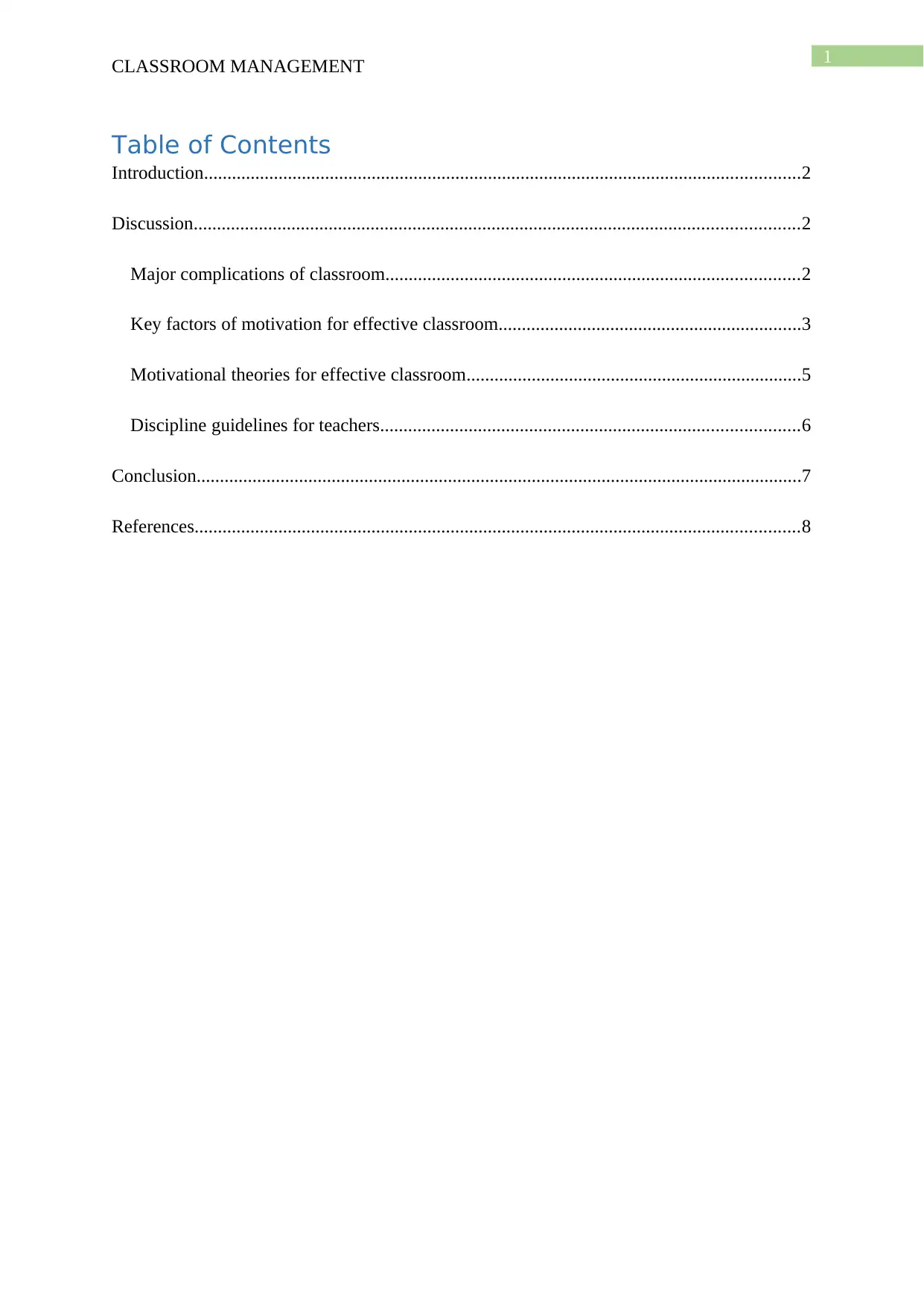
1
CLASSROOM MANAGEMENT
Table of Contents
Introduction................................................................................................................................2
Discussion..................................................................................................................................2
Major complications of classroom.........................................................................................2
Key factors of motivation for effective classroom.................................................................3
Motivational theories for effective classroom........................................................................5
Discipline guidelines for teachers..........................................................................................6
Conclusion..................................................................................................................................7
References..................................................................................................................................8
CLASSROOM MANAGEMENT
Table of Contents
Introduction................................................................................................................................2
Discussion..................................................................................................................................2
Major complications of classroom.........................................................................................2
Key factors of motivation for effective classroom.................................................................3
Motivational theories for effective classroom........................................................................5
Discipline guidelines for teachers..........................................................................................6
Conclusion..................................................................................................................................7
References..................................................................................................................................8
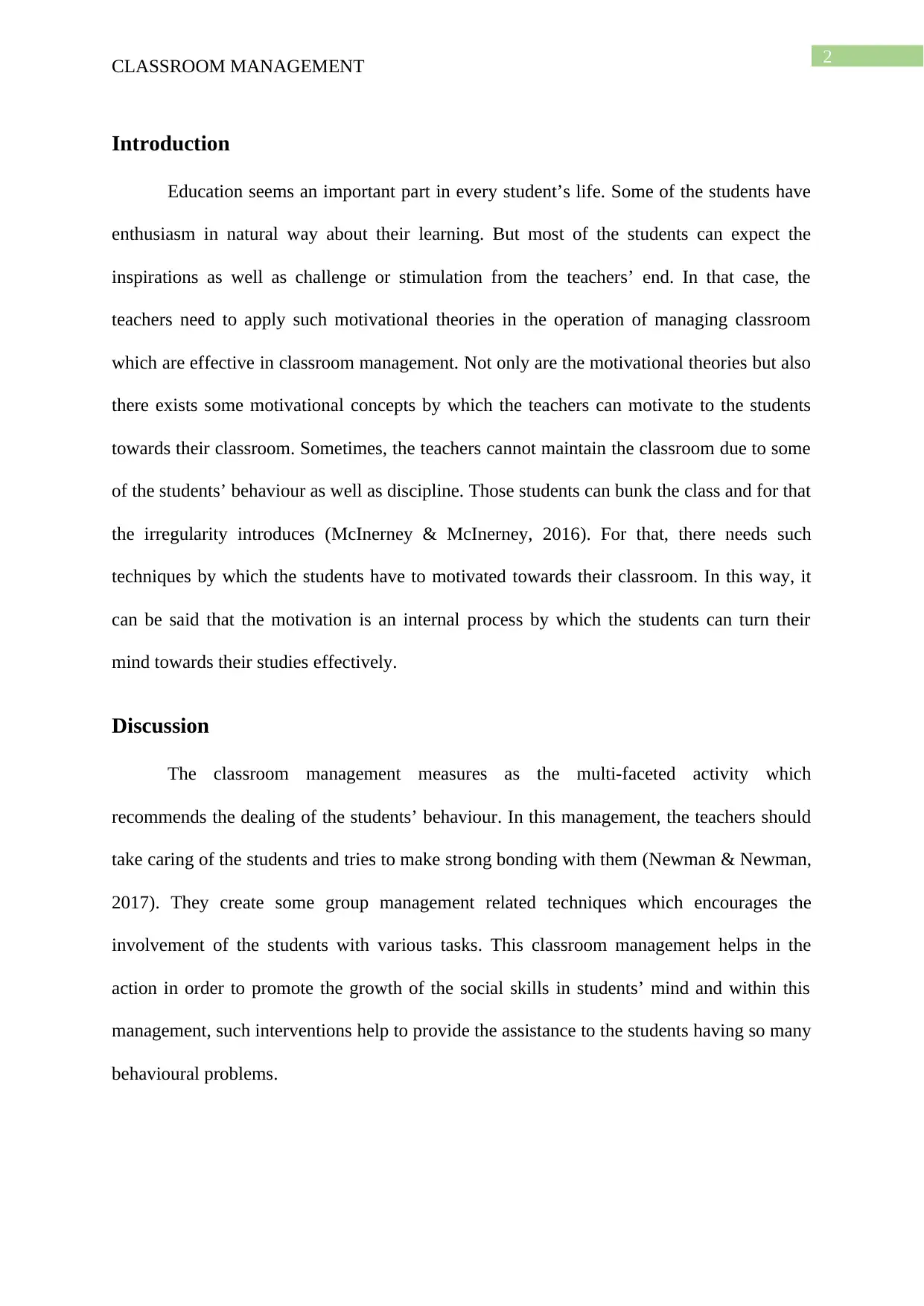
2
CLASSROOM MANAGEMENT
Introduction
Education seems an important part in every student’s life. Some of the students have
enthusiasm in natural way about their learning. But most of the students can expect the
inspirations as well as challenge or stimulation from the teachers’ end. In that case, the
teachers need to apply such motivational theories in the operation of managing classroom
which are effective in classroom management. Not only are the motivational theories but also
there exists some motivational concepts by which the teachers can motivate to the students
towards their classroom. Sometimes, the teachers cannot maintain the classroom due to some
of the students’ behaviour as well as discipline. Those students can bunk the class and for that
the irregularity introduces (McInerney & McInerney, 2016). For that, there needs such
techniques by which the students have to motivated towards their classroom. In this way, it
can be said that the motivation is an internal process by which the students can turn their
mind towards their studies effectively.
Discussion
The classroom management measures as the multi-faceted activity which
recommends the dealing of the students’ behaviour. In this management, the teachers should
take caring of the students and tries to make strong bonding with them (Newman & Newman,
2017). They create some group management related techniques which encourages the
involvement of the students with various tasks. This classroom management helps in the
action in order to promote the growth of the social skills in students’ mind and within this
management, such interventions help to provide the assistance to the students having so many
behavioural problems.
CLASSROOM MANAGEMENT
Introduction
Education seems an important part in every student’s life. Some of the students have
enthusiasm in natural way about their learning. But most of the students can expect the
inspirations as well as challenge or stimulation from the teachers’ end. In that case, the
teachers need to apply such motivational theories in the operation of managing classroom
which are effective in classroom management. Not only are the motivational theories but also
there exists some motivational concepts by which the teachers can motivate to the students
towards their classroom. Sometimes, the teachers cannot maintain the classroom due to some
of the students’ behaviour as well as discipline. Those students can bunk the class and for that
the irregularity introduces (McInerney & McInerney, 2016). For that, there needs such
techniques by which the students have to motivated towards their classroom. In this way, it
can be said that the motivation is an internal process by which the students can turn their
mind towards their studies effectively.
Discussion
The classroom management measures as the multi-faceted activity which
recommends the dealing of the students’ behaviour. In this management, the teachers should
take caring of the students and tries to make strong bonding with them (Newman & Newman,
2017). They create some group management related techniques which encourages the
involvement of the students with various tasks. This classroom management helps in the
action in order to promote the growth of the social skills in students’ mind and within this
management, such interventions help to provide the assistance to the students having so many
behavioural problems.
⊘ This is a preview!⊘
Do you want full access?
Subscribe today to unlock all pages.

Trusted by 1+ million students worldwide
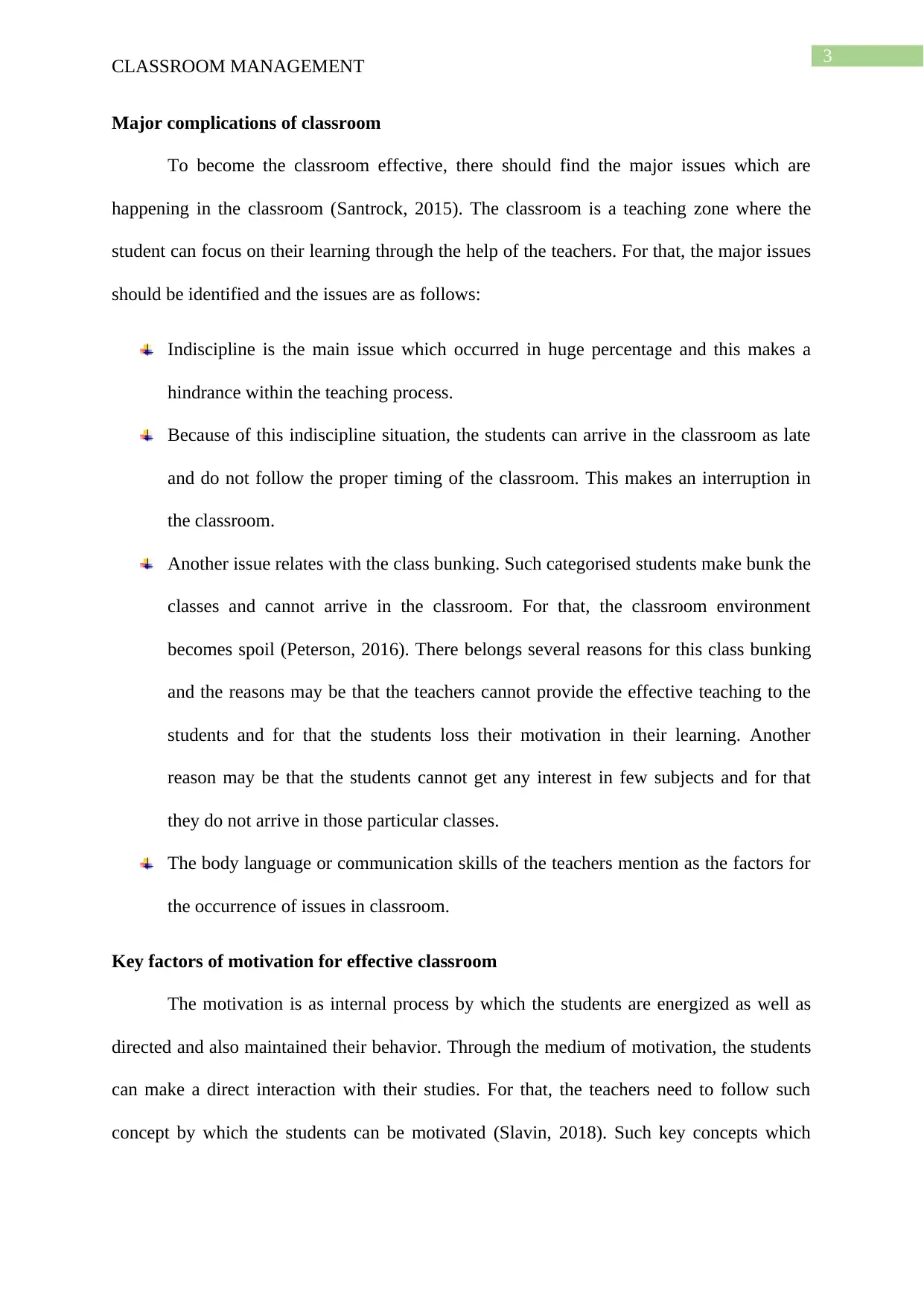
3
CLASSROOM MANAGEMENT
Major complications of classroom
To become the classroom effective, there should find the major issues which are
happening in the classroom (Santrock, 2015). The classroom is a teaching zone where the
student can focus on their learning through the help of the teachers. For that, the major issues
should be identified and the issues are as follows:
Indiscipline is the main issue which occurred in huge percentage and this makes a
hindrance within the teaching process.
Because of this indiscipline situation, the students can arrive in the classroom as late
and do not follow the proper timing of the classroom. This makes an interruption in
the classroom.
Another issue relates with the class bunking. Such categorised students make bunk the
classes and cannot arrive in the classroom. For that, the classroom environment
becomes spoil (Peterson, 2016). There belongs several reasons for this class bunking
and the reasons may be that the teachers cannot provide the effective teaching to the
students and for that the students loss their motivation in their learning. Another
reason may be that the students cannot get any interest in few subjects and for that
they do not arrive in those particular classes.
The body language or communication skills of the teachers mention as the factors for
the occurrence of issues in classroom.
Key factors of motivation for effective classroom
The motivation is as internal process by which the students are energized as well as
directed and also maintained their behavior. Through the medium of motivation, the students
can make a direct interaction with their studies. For that, the teachers need to follow such
concept by which the students can be motivated (Slavin, 2018). Such key concepts which
CLASSROOM MANAGEMENT
Major complications of classroom
To become the classroom effective, there should find the major issues which are
happening in the classroom (Santrock, 2015). The classroom is a teaching zone where the
student can focus on their learning through the help of the teachers. For that, the major issues
should be identified and the issues are as follows:
Indiscipline is the main issue which occurred in huge percentage and this makes a
hindrance within the teaching process.
Because of this indiscipline situation, the students can arrive in the classroom as late
and do not follow the proper timing of the classroom. This makes an interruption in
the classroom.
Another issue relates with the class bunking. Such categorised students make bunk the
classes and cannot arrive in the classroom. For that, the classroom environment
becomes spoil (Peterson, 2016). There belongs several reasons for this class bunking
and the reasons may be that the teachers cannot provide the effective teaching to the
students and for that the students loss their motivation in their learning. Another
reason may be that the students cannot get any interest in few subjects and for that
they do not arrive in those particular classes.
The body language or communication skills of the teachers mention as the factors for
the occurrence of issues in classroom.
Key factors of motivation for effective classroom
The motivation is as internal process by which the students are energized as well as
directed and also maintained their behavior. Through the medium of motivation, the students
can make a direct interaction with their studies. For that, the teachers need to follow such
concept by which the students can be motivated (Slavin, 2018). Such key concepts which
Paraphrase This Document
Need a fresh take? Get an instant paraphrase of this document with our AI Paraphraser
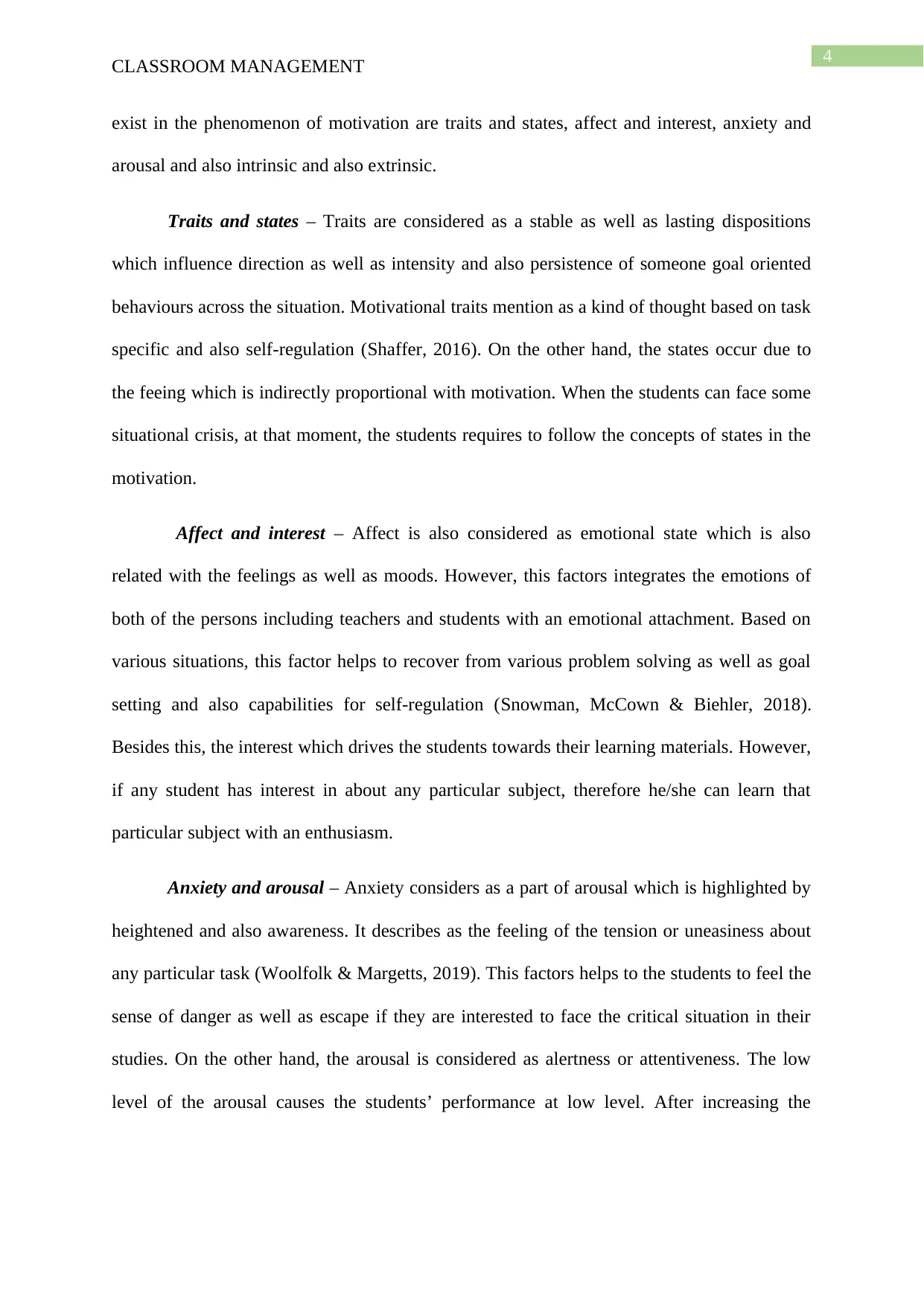
4
CLASSROOM MANAGEMENT
exist in the phenomenon of motivation are traits and states, affect and interest, anxiety and
arousal and also intrinsic and also extrinsic.
Traits and states – Traits are considered as a stable as well as lasting dispositions
which influence direction as well as intensity and also persistence of someone goal oriented
behaviours across the situation. Motivational traits mention as a kind of thought based on task
specific and also self-regulation (Shaffer, 2016). On the other hand, the states occur due to
the feeing which is indirectly proportional with motivation. When the students can face some
situational crisis, at that moment, the students requires to follow the concepts of states in the
motivation.
Affect and interest – Affect is also considered as emotional state which is also
related with the feelings as well as moods. However, this factors integrates the emotions of
both of the persons including teachers and students with an emotional attachment. Based on
various situations, this factor helps to recover from various problem solving as well as goal
setting and also capabilities for self-regulation (Snowman, McCown & Biehler, 2018).
Besides this, the interest which drives the students towards their learning materials. However,
if any student has interest in about any particular subject, therefore he/she can learn that
particular subject with an enthusiasm.
Anxiety and arousal – Anxiety considers as a part of arousal which is highlighted by
heightened and also awareness. It describes as the feeling of the tension or uneasiness about
any particular task (Woolfolk & Margetts, 2019). This factors helps to the students to feel the
sense of danger as well as escape if they are interested to face the critical situation in their
studies. On the other hand, the arousal is considered as alertness or attentiveness. The low
level of the arousal causes the students’ performance at low level. After increasing the
CLASSROOM MANAGEMENT
exist in the phenomenon of motivation are traits and states, affect and interest, anxiety and
arousal and also intrinsic and also extrinsic.
Traits and states – Traits are considered as a stable as well as lasting dispositions
which influence direction as well as intensity and also persistence of someone goal oriented
behaviours across the situation. Motivational traits mention as a kind of thought based on task
specific and also self-regulation (Shaffer, 2016). On the other hand, the states occur due to
the feeing which is indirectly proportional with motivation. When the students can face some
situational crisis, at that moment, the students requires to follow the concepts of states in the
motivation.
Affect and interest – Affect is also considered as emotional state which is also
related with the feelings as well as moods. However, this factors integrates the emotions of
both of the persons including teachers and students with an emotional attachment. Based on
various situations, this factor helps to recover from various problem solving as well as goal
setting and also capabilities for self-regulation (Snowman, McCown & Biehler, 2018).
Besides this, the interest which drives the students towards their learning materials. However,
if any student has interest in about any particular subject, therefore he/she can learn that
particular subject with an enthusiasm.
Anxiety and arousal – Anxiety considers as a part of arousal which is highlighted by
heightened and also awareness. It describes as the feeling of the tension or uneasiness about
any particular task (Woolfolk & Margetts, 2019). This factors helps to the students to feel the
sense of danger as well as escape if they are interested to face the critical situation in their
studies. On the other hand, the arousal is considered as alertness or attentiveness. The low
level of the arousal causes the students’ performance at low level. After increasing the
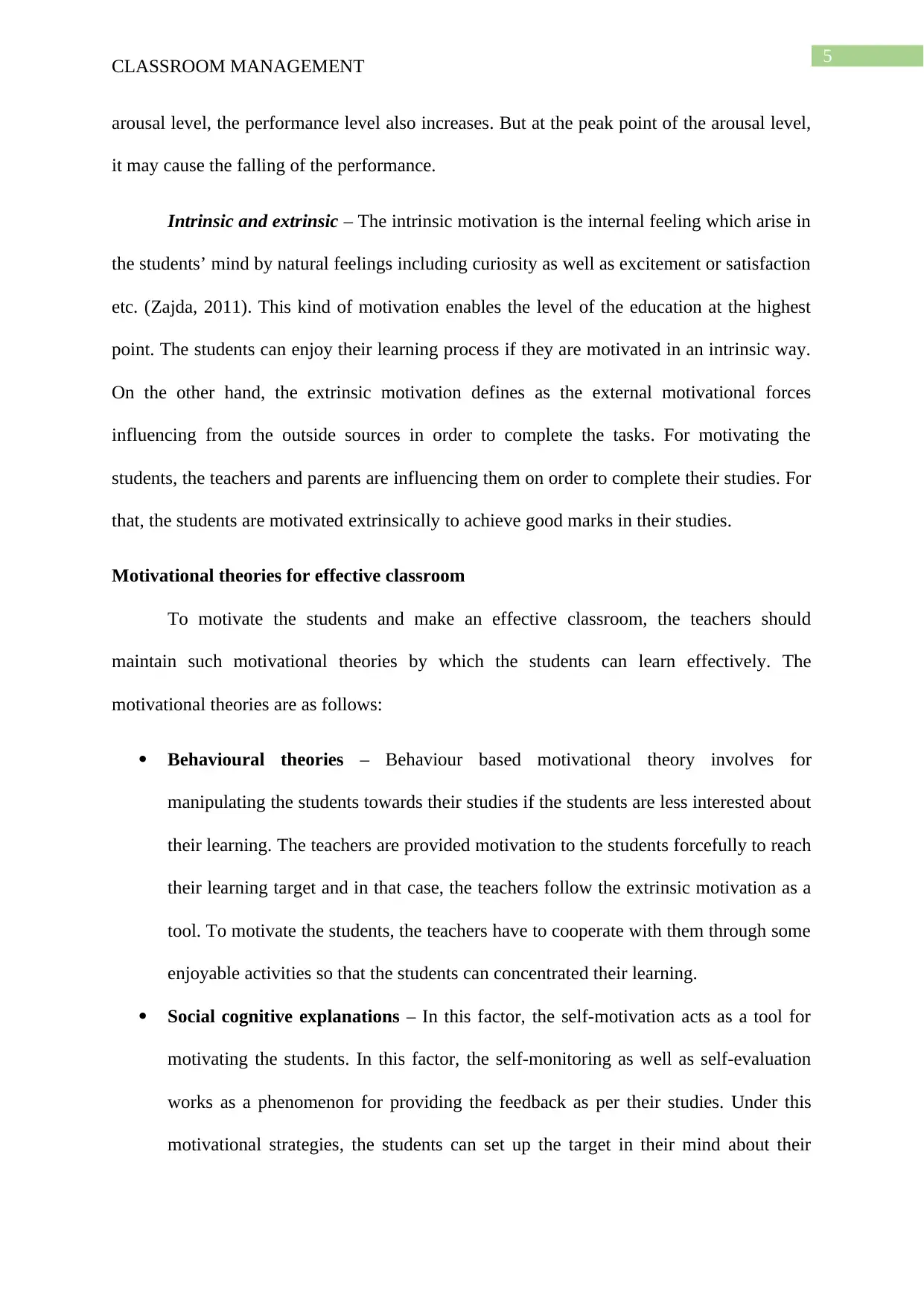
5
CLASSROOM MANAGEMENT
arousal level, the performance level also increases. But at the peak point of the arousal level,
it may cause the falling of the performance.
Intrinsic and extrinsic – The intrinsic motivation is the internal feeling which arise in
the students’ mind by natural feelings including curiosity as well as excitement or satisfaction
etc. (Zajda, 2011). This kind of motivation enables the level of the education at the highest
point. The students can enjoy their learning process if they are motivated in an intrinsic way.
On the other hand, the extrinsic motivation defines as the external motivational forces
influencing from the outside sources in order to complete the tasks. For motivating the
students, the teachers and parents are influencing them on order to complete their studies. For
that, the students are motivated extrinsically to achieve good marks in their studies.
Motivational theories for effective classroom
To motivate the students and make an effective classroom, the teachers should
maintain such motivational theories by which the students can learn effectively. The
motivational theories are as follows:
Behavioural theories – Behaviour based motivational theory involves for
manipulating the students towards their studies if the students are less interested about
their learning. The teachers are provided motivation to the students forcefully to reach
their learning target and in that case, the teachers follow the extrinsic motivation as a
tool. To motivate the students, the teachers have to cooperate with them through some
enjoyable activities so that the students can concentrated their learning.
Social cognitive explanations – In this factor, the self-motivation acts as a tool for
motivating the students. In this factor, the self-monitoring as well as self-evaluation
works as a phenomenon for providing the feedback as per their studies. Under this
motivational strategies, the students can set up the target in their mind about their
CLASSROOM MANAGEMENT
arousal level, the performance level also increases. But at the peak point of the arousal level,
it may cause the falling of the performance.
Intrinsic and extrinsic – The intrinsic motivation is the internal feeling which arise in
the students’ mind by natural feelings including curiosity as well as excitement or satisfaction
etc. (Zajda, 2011). This kind of motivation enables the level of the education at the highest
point. The students can enjoy their learning process if they are motivated in an intrinsic way.
On the other hand, the extrinsic motivation defines as the external motivational forces
influencing from the outside sources in order to complete the tasks. For motivating the
students, the teachers and parents are influencing them on order to complete their studies. For
that, the students are motivated extrinsically to achieve good marks in their studies.
Motivational theories for effective classroom
To motivate the students and make an effective classroom, the teachers should
maintain such motivational theories by which the students can learn effectively. The
motivational theories are as follows:
Behavioural theories – Behaviour based motivational theory involves for
manipulating the students towards their studies if the students are less interested about
their learning. The teachers are provided motivation to the students forcefully to reach
their learning target and in that case, the teachers follow the extrinsic motivation as a
tool. To motivate the students, the teachers have to cooperate with them through some
enjoyable activities so that the students can concentrated their learning.
Social cognitive explanations – In this factor, the self-motivation acts as a tool for
motivating the students. In this factor, the self-monitoring as well as self-evaluation
works as a phenomenon for providing the feedback as per their studies. Under this
motivational strategies, the students can set up the target in their mind about their
⊘ This is a preview!⊘
Do you want full access?
Subscribe today to unlock all pages.

Trusted by 1+ million students worldwide
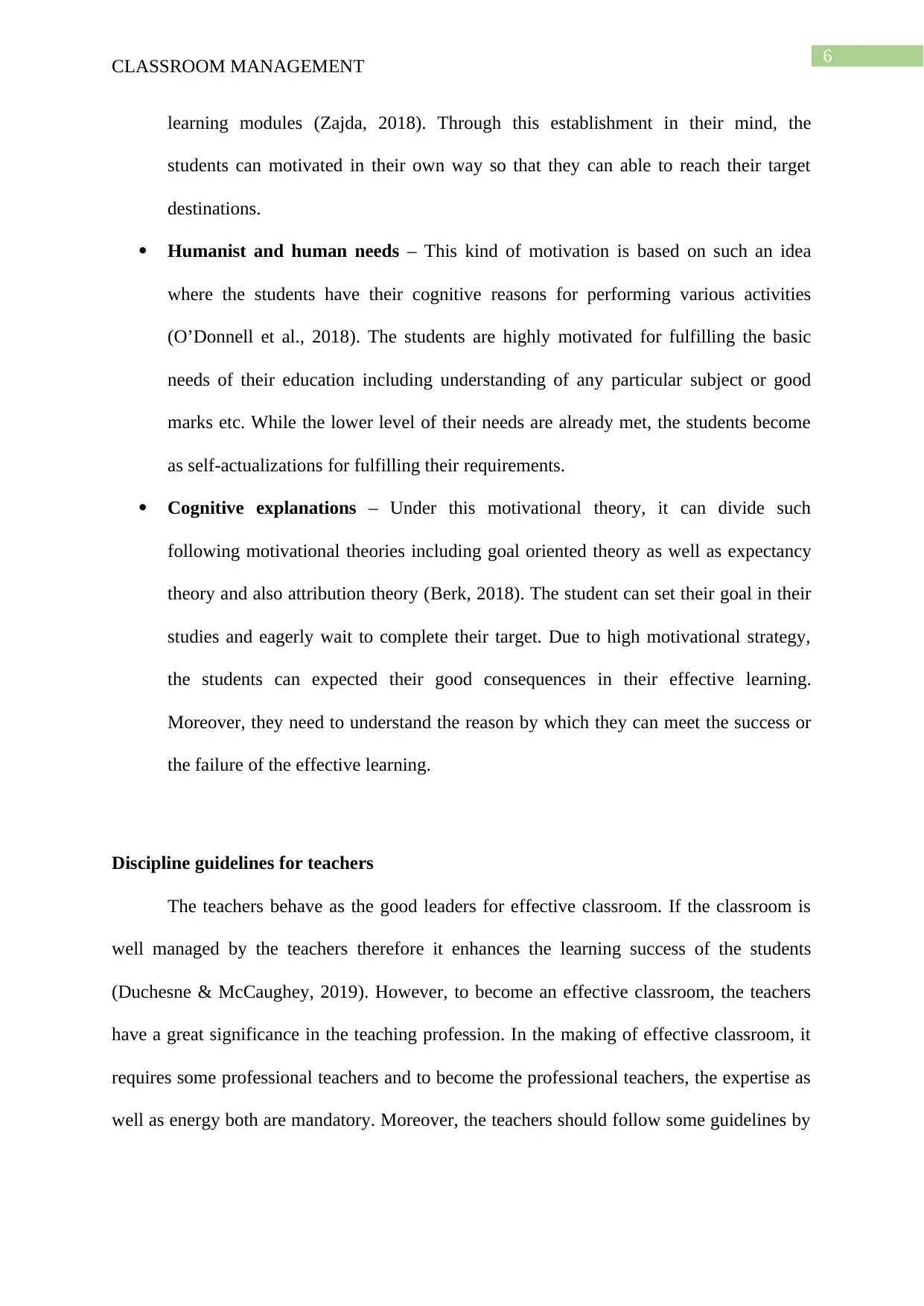
6
CLASSROOM MANAGEMENT
learning modules (Zajda, 2018). Through this establishment in their mind, the
students can motivated in their own way so that they can able to reach their target
destinations.
Humanist and human needs – This kind of motivation is based on such an idea
where the students have their cognitive reasons for performing various activities
(O’Donnell et al., 2018). The students are highly motivated for fulfilling the basic
needs of their education including understanding of any particular subject or good
marks etc. While the lower level of their needs are already met, the students become
as self-actualizations for fulfilling their requirements.
Cognitive explanations – Under this motivational theory, it can divide such
following motivational theories including goal oriented theory as well as expectancy
theory and also attribution theory (Berk, 2018). The student can set their goal in their
studies and eagerly wait to complete their target. Due to high motivational strategy,
the students can expected their good consequences in their effective learning.
Moreover, they need to understand the reason by which they can meet the success or
the failure of the effective learning.
Discipline guidelines for teachers
The teachers behave as the good leaders for effective classroom. If the classroom is
well managed by the teachers therefore it enhances the learning success of the students
(Duchesne & McCaughey, 2019). However, to become an effective classroom, the teachers
have a great significance in the teaching profession. In the making of effective classroom, it
requires some professional teachers and to become the professional teachers, the expertise as
well as energy both are mandatory. Moreover, the teachers should follow some guidelines by
CLASSROOM MANAGEMENT
learning modules (Zajda, 2018). Through this establishment in their mind, the
students can motivated in their own way so that they can able to reach their target
destinations.
Humanist and human needs – This kind of motivation is based on such an idea
where the students have their cognitive reasons for performing various activities
(O’Donnell et al., 2018). The students are highly motivated for fulfilling the basic
needs of their education including understanding of any particular subject or good
marks etc. While the lower level of their needs are already met, the students become
as self-actualizations for fulfilling their requirements.
Cognitive explanations – Under this motivational theory, it can divide such
following motivational theories including goal oriented theory as well as expectancy
theory and also attribution theory (Berk, 2018). The student can set their goal in their
studies and eagerly wait to complete their target. Due to high motivational strategy,
the students can expected their good consequences in their effective learning.
Moreover, they need to understand the reason by which they can meet the success or
the failure of the effective learning.
Discipline guidelines for teachers
The teachers behave as the good leaders for effective classroom. If the classroom is
well managed by the teachers therefore it enhances the learning success of the students
(Duchesne & McCaughey, 2019). However, to become an effective classroom, the teachers
have a great significance in the teaching profession. In the making of effective classroom, it
requires some professional teachers and to become the professional teachers, the expertise as
well as energy both are mandatory. Moreover, the teachers should follow some guidelines by
Paraphrase This Document
Need a fresh take? Get an instant paraphrase of this document with our AI Paraphraser
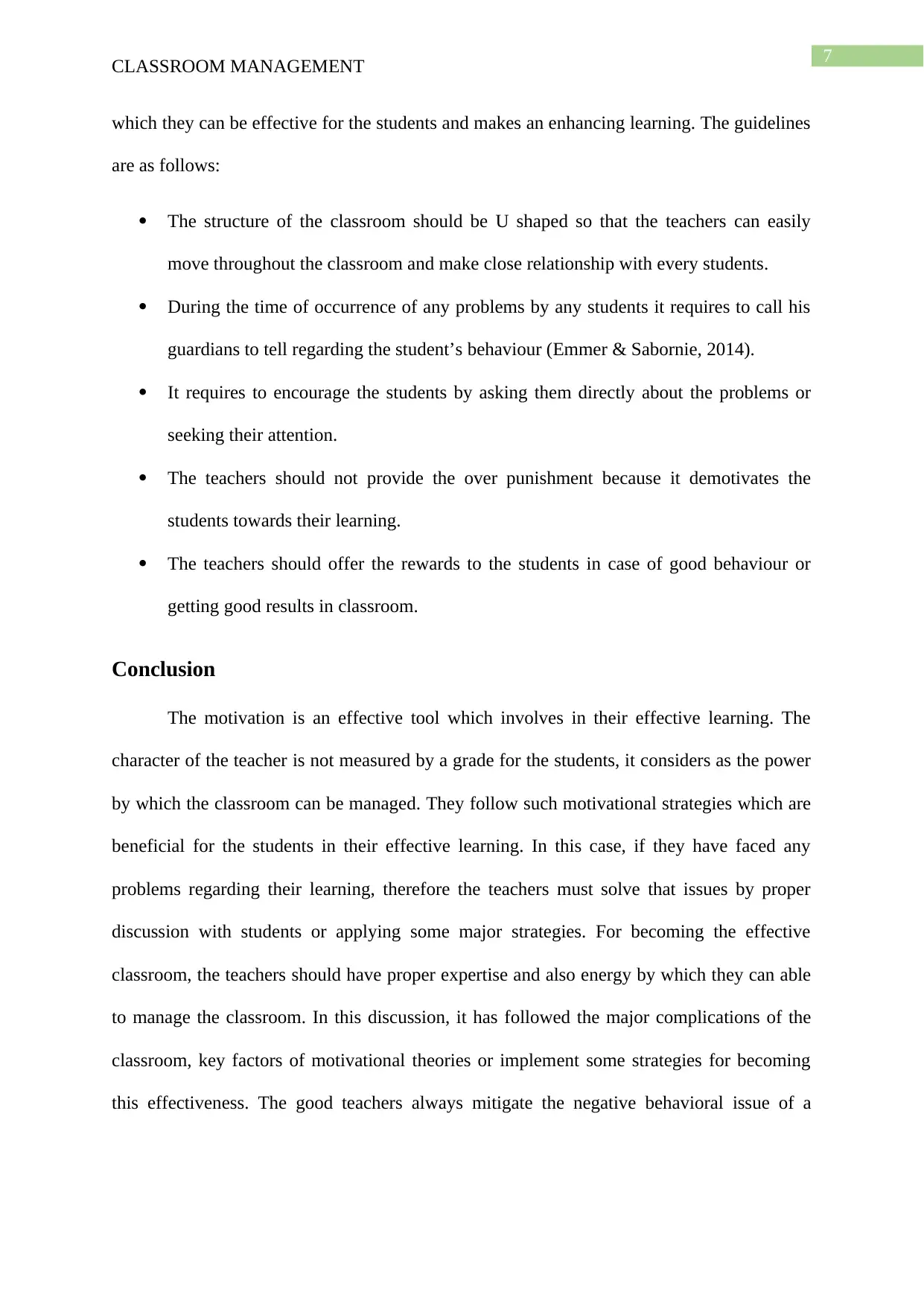
7
CLASSROOM MANAGEMENT
which they can be effective for the students and makes an enhancing learning. The guidelines
are as follows:
The structure of the classroom should be U shaped so that the teachers can easily
move throughout the classroom and make close relationship with every students.
During the time of occurrence of any problems by any students it requires to call his
guardians to tell regarding the student’s behaviour (Emmer & Sabornie, 2014).
It requires to encourage the students by asking them directly about the problems or
seeking their attention.
The teachers should not provide the over punishment because it demotivates the
students towards their learning.
The teachers should offer the rewards to the students in case of good behaviour or
getting good results in classroom.
Conclusion
The motivation is an effective tool which involves in their effective learning. The
character of the teacher is not measured by a grade for the students, it considers as the power
by which the classroom can be managed. They follow such motivational strategies which are
beneficial for the students in their effective learning. In this case, if they have faced any
problems regarding their learning, therefore the teachers must solve that issues by proper
discussion with students or applying some major strategies. For becoming the effective
classroom, the teachers should have proper expertise and also energy by which they can able
to manage the classroom. In this discussion, it has followed the major complications of the
classroom, key factors of motivational theories or implement some strategies for becoming
this effectiveness. The good teachers always mitigate the negative behavioral issue of a
CLASSROOM MANAGEMENT
which they can be effective for the students and makes an enhancing learning. The guidelines
are as follows:
The structure of the classroom should be U shaped so that the teachers can easily
move throughout the classroom and make close relationship with every students.
During the time of occurrence of any problems by any students it requires to call his
guardians to tell regarding the student’s behaviour (Emmer & Sabornie, 2014).
It requires to encourage the students by asking them directly about the problems or
seeking their attention.
The teachers should not provide the over punishment because it demotivates the
students towards their learning.
The teachers should offer the rewards to the students in case of good behaviour or
getting good results in classroom.
Conclusion
The motivation is an effective tool which involves in their effective learning. The
character of the teacher is not measured by a grade for the students, it considers as the power
by which the classroom can be managed. They follow such motivational strategies which are
beneficial for the students in their effective learning. In this case, if they have faced any
problems regarding their learning, therefore the teachers must solve that issues by proper
discussion with students or applying some major strategies. For becoming the effective
classroom, the teachers should have proper expertise and also energy by which they can able
to manage the classroom. In this discussion, it has followed the major complications of the
classroom, key factors of motivational theories or implement some strategies for becoming
this effectiveness. The good teachers always mitigate the negative behavioral issue of a
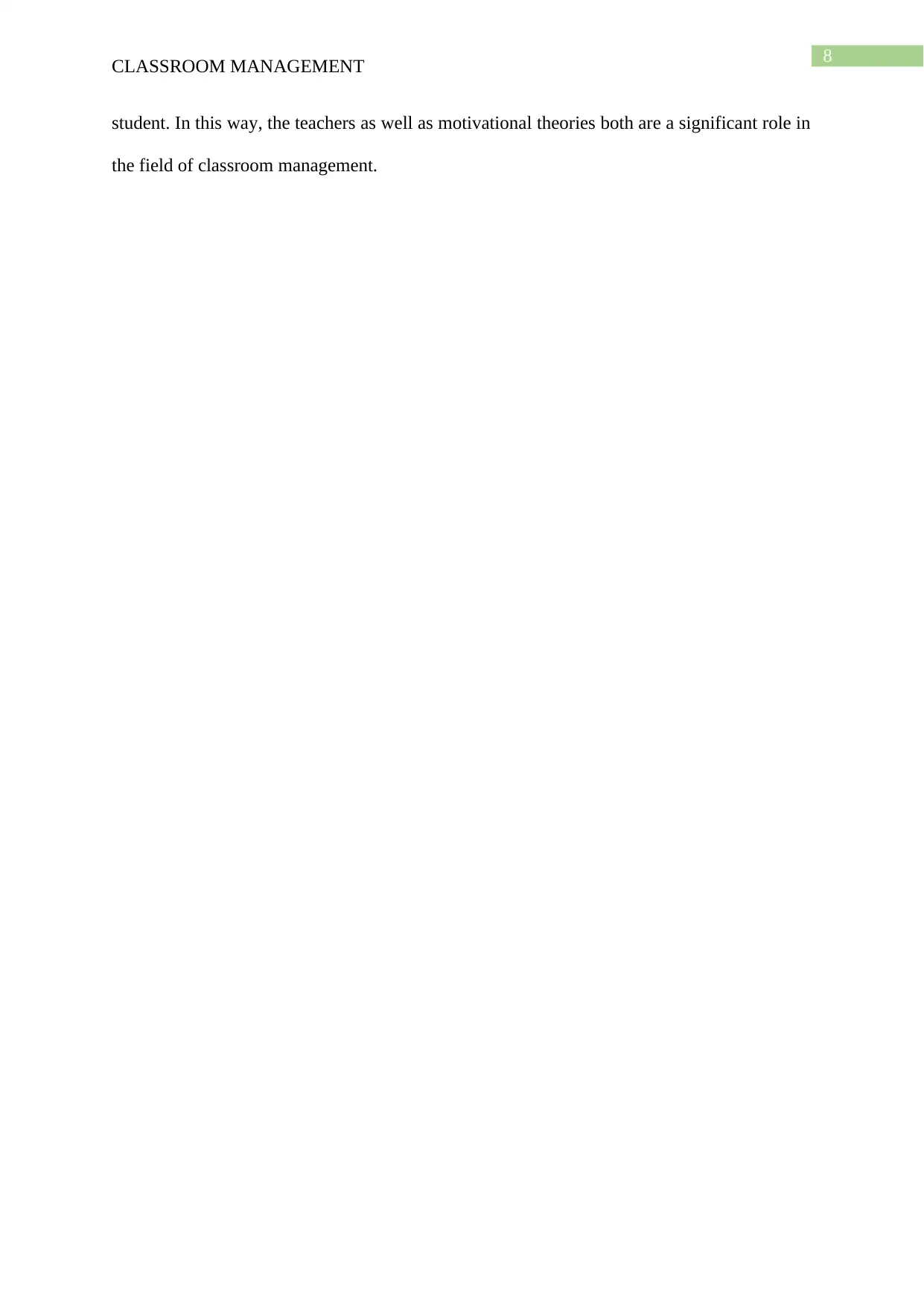
8
CLASSROOM MANAGEMENT
student. In this way, the teachers as well as motivational theories both are a significant role in
the field of classroom management.
CLASSROOM MANAGEMENT
student. In this way, the teachers as well as motivational theories both are a significant role in
the field of classroom management.
⊘ This is a preview!⊘
Do you want full access?
Subscribe today to unlock all pages.

Trusted by 1+ million students worldwide
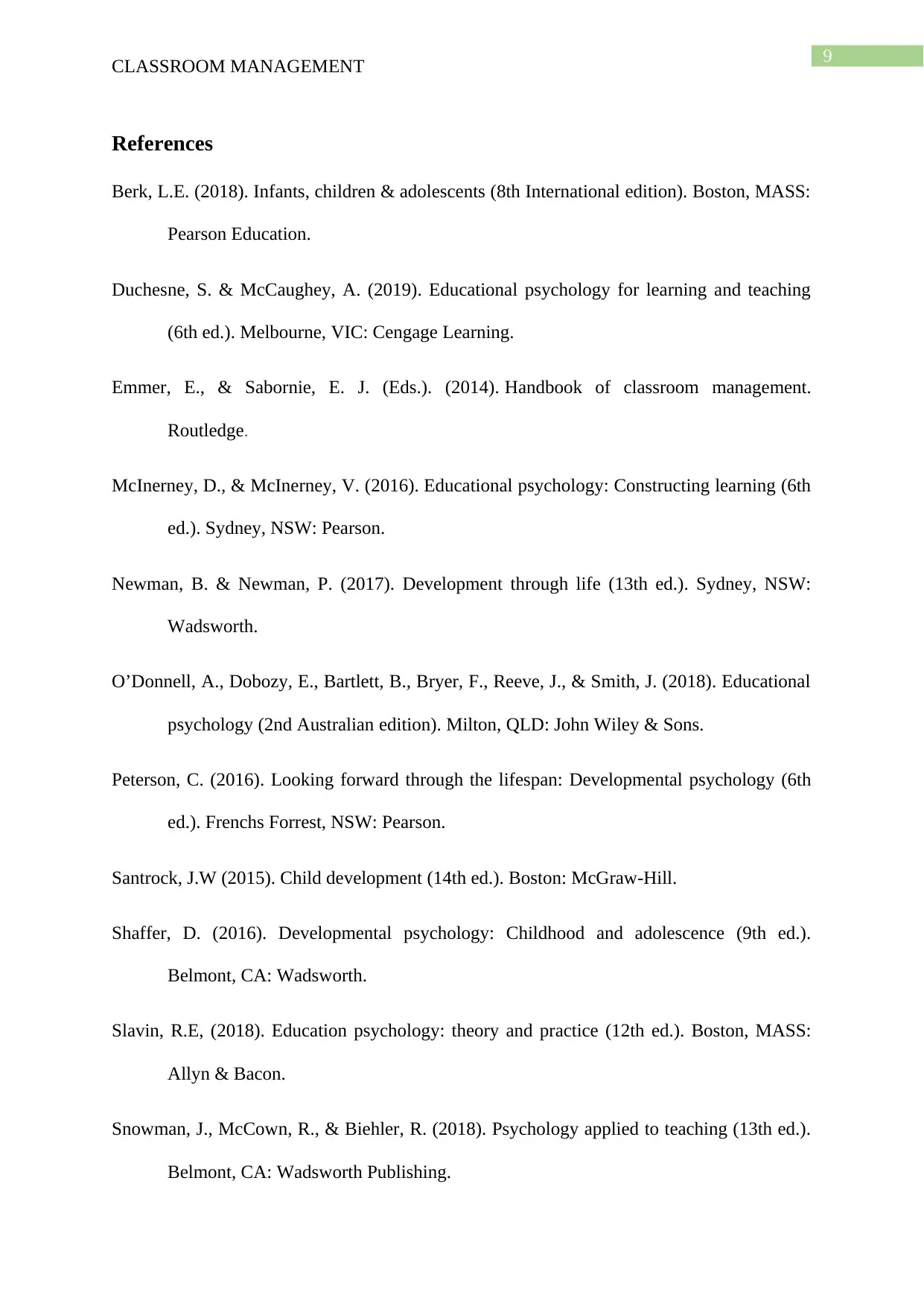
9
CLASSROOM MANAGEMENT
References
Berk, L.E. (2018). Infants, children & adolescents (8th International edition). Boston, MASS:
Pearson Education.
Duchesne, S. & McCaughey, A. (2019). Educational psychology for learning and teaching
(6th ed.). Melbourne, VIC: Cengage Learning.
Emmer, E., & Sabornie, E. J. (Eds.). (2014). Handbook of classroom management.
Routledge.
McInerney, D., & McInerney, V. (2016). Educational psychology: Constructing learning (6th
ed.). Sydney, NSW: Pearson.
Newman, B. & Newman, P. (2017). Development through life (13th ed.). Sydney, NSW:
Wadsworth.
O’Donnell, A., Dobozy, E., Bartlett, B., Bryer, F., Reeve, J., & Smith, J. (2018). Educational
psychology (2nd Australian edition). Milton, QLD: John Wiley & Sons.
Peterson, C. (2016). Looking forward through the lifespan: Developmental psychology (6th
ed.). Frenchs Forrest, NSW: Pearson.
Santrock, J.W (2015). Child development (14th ed.). Boston: McGraw-Hill.
Shaffer, D. (2016). Developmental psychology: Childhood and adolescence (9th ed.).
Belmont, CA: Wadsworth.
Slavin, R.E, (2018). Education psychology: theory and practice (12th ed.). Boston, MASS:
Allyn & Bacon.
Snowman, J., McCown, R., & Biehler, R. (2018). Psychology applied to teaching (13th ed.).
Belmont, CA: Wadsworth Publishing.
CLASSROOM MANAGEMENT
References
Berk, L.E. (2018). Infants, children & adolescents (8th International edition). Boston, MASS:
Pearson Education.
Duchesne, S. & McCaughey, A. (2019). Educational psychology for learning and teaching
(6th ed.). Melbourne, VIC: Cengage Learning.
Emmer, E., & Sabornie, E. J. (Eds.). (2014). Handbook of classroom management.
Routledge.
McInerney, D., & McInerney, V. (2016). Educational psychology: Constructing learning (6th
ed.). Sydney, NSW: Pearson.
Newman, B. & Newman, P. (2017). Development through life (13th ed.). Sydney, NSW:
Wadsworth.
O’Donnell, A., Dobozy, E., Bartlett, B., Bryer, F., Reeve, J., & Smith, J. (2018). Educational
psychology (2nd Australian edition). Milton, QLD: John Wiley & Sons.
Peterson, C. (2016). Looking forward through the lifespan: Developmental psychology (6th
ed.). Frenchs Forrest, NSW: Pearson.
Santrock, J.W (2015). Child development (14th ed.). Boston: McGraw-Hill.
Shaffer, D. (2016). Developmental psychology: Childhood and adolescence (9th ed.).
Belmont, CA: Wadsworth.
Slavin, R.E, (2018). Education psychology: theory and practice (12th ed.). Boston, MASS:
Allyn & Bacon.
Snowman, J., McCown, R., & Biehler, R. (2018). Psychology applied to teaching (13th ed.).
Belmont, CA: Wadsworth Publishing.
Paraphrase This Document
Need a fresh take? Get an instant paraphrase of this document with our AI Paraphraser
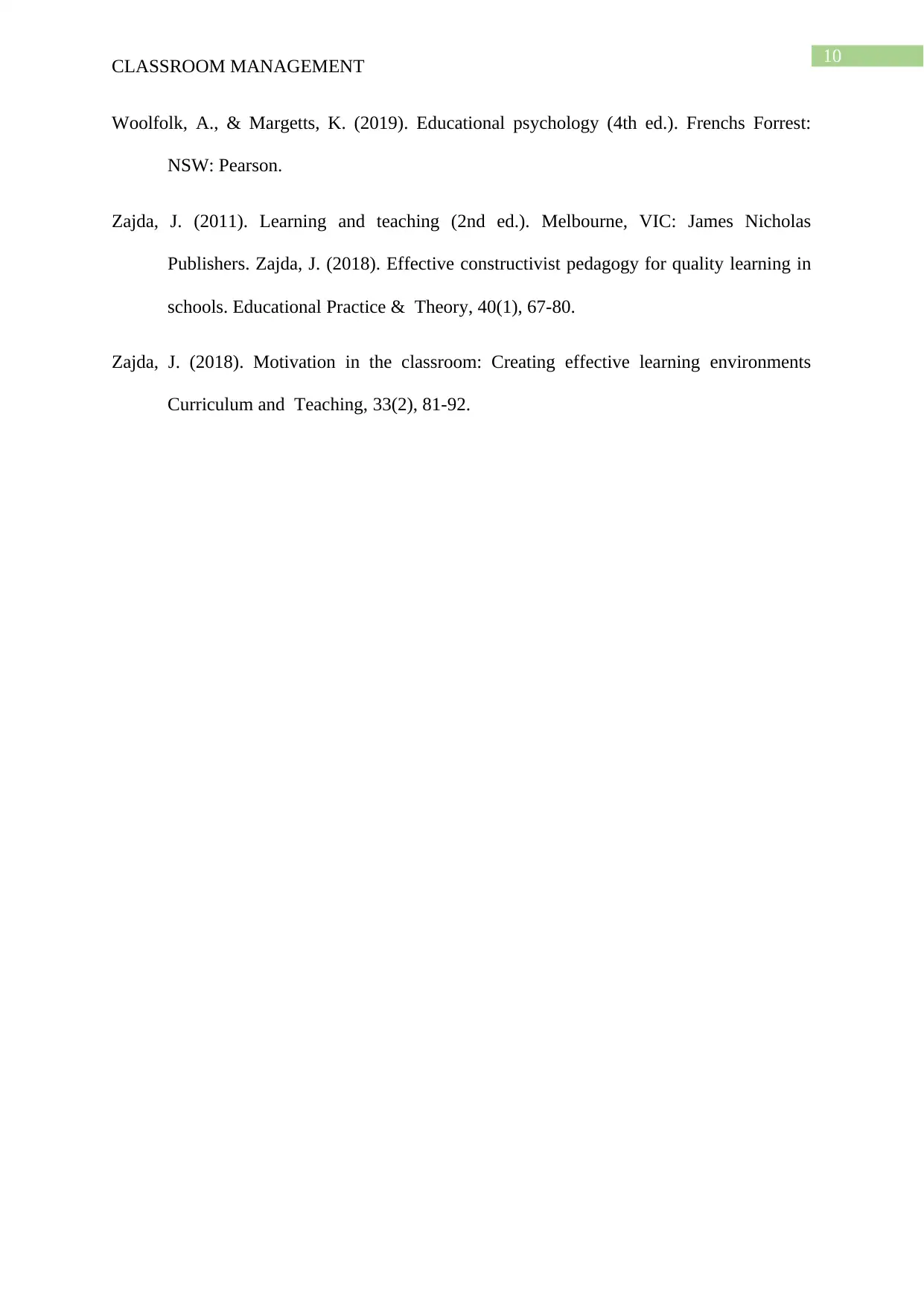
10
CLASSROOM MANAGEMENT
Woolfolk, A., & Margetts, K. (2019). Educational psychology (4th ed.). Frenchs Forrest:
NSW: Pearson.
Zajda, J. (2011). Learning and teaching (2nd ed.). Melbourne, VIC: James Nicholas
Publishers. Zajda, J. (2018). Effective constructivist pedagogy for quality learning in
schools. Educational Practice & Theory, 40(1), 67-80.
Zajda, J. (2018). Motivation in the classroom: Creating effective learning environments
Curriculum and Teaching, 33(2), 81-92.
CLASSROOM MANAGEMENT
Woolfolk, A., & Margetts, K. (2019). Educational psychology (4th ed.). Frenchs Forrest:
NSW: Pearson.
Zajda, J. (2011). Learning and teaching (2nd ed.). Melbourne, VIC: James Nicholas
Publishers. Zajda, J. (2018). Effective constructivist pedagogy for quality learning in
schools. Educational Practice & Theory, 40(1), 67-80.
Zajda, J. (2018). Motivation in the classroom: Creating effective learning environments
Curriculum and Teaching, 33(2), 81-92.
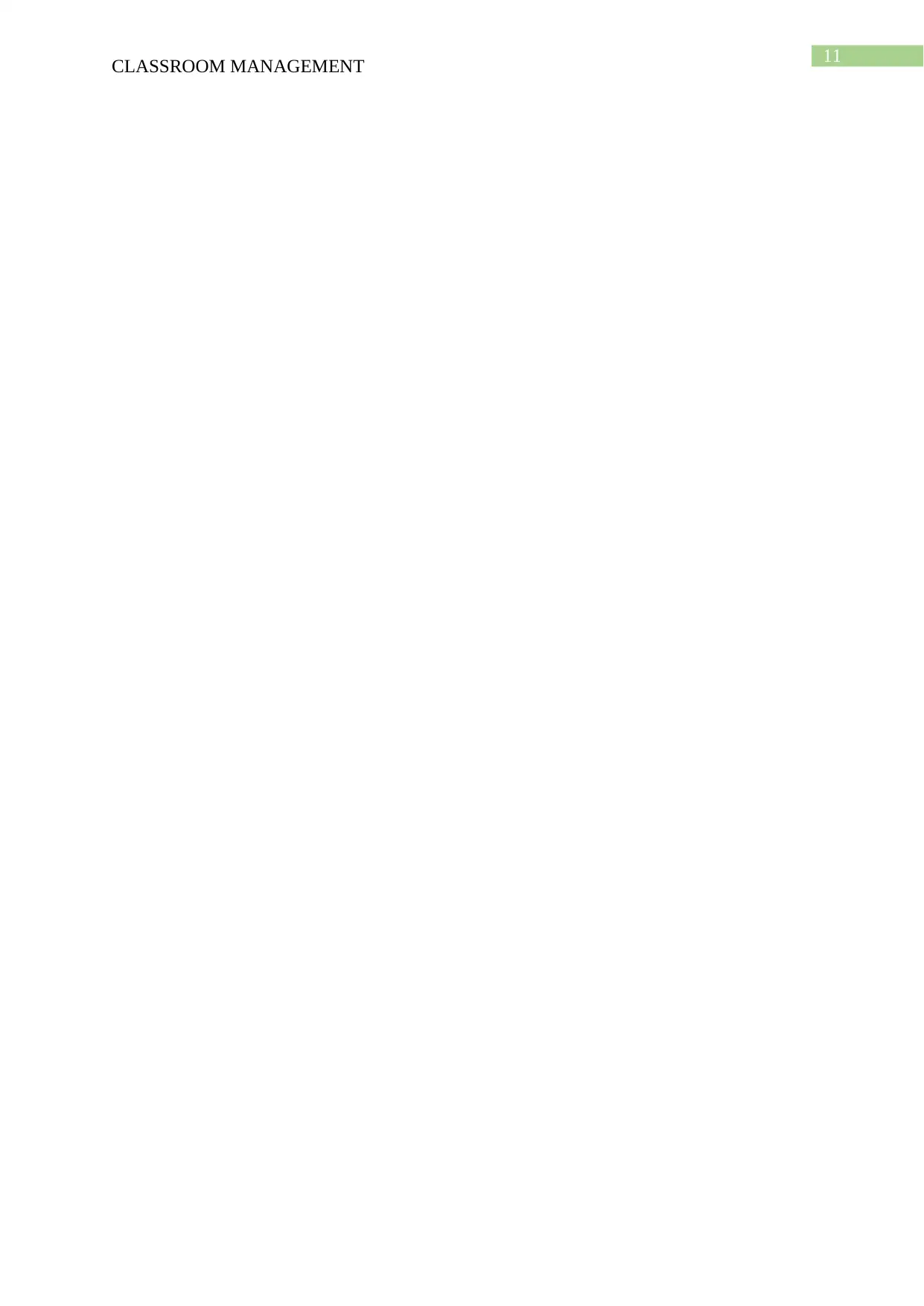
11
CLASSROOM MANAGEMENT
CLASSROOM MANAGEMENT
⊘ This is a preview!⊘
Do you want full access?
Subscribe today to unlock all pages.

Trusted by 1+ million students worldwide
1 out of 12
Related Documents
Your All-in-One AI-Powered Toolkit for Academic Success.
+13062052269
info@desklib.com
Available 24*7 on WhatsApp / Email
![[object Object]](/_next/static/media/star-bottom.7253800d.svg)
Unlock your academic potential
Copyright © 2020–2025 A2Z Services. All Rights Reserved. Developed and managed by ZUCOL.





